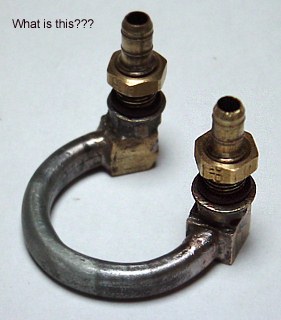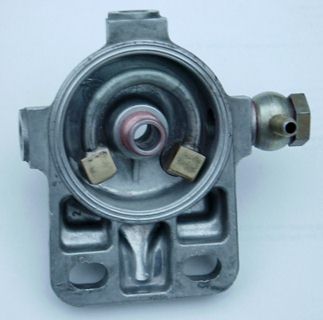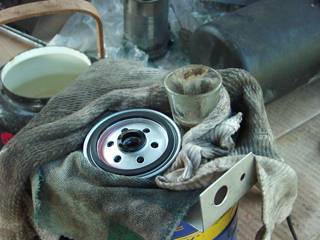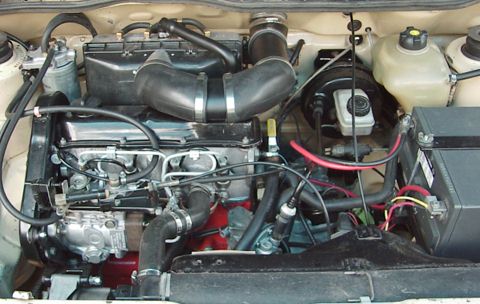EV Pusher - Page Seven
EV Pusher Project
Archive Page Seven
 December 5, 2001. Today is the first anniversary of the Pusher Project, and I'd like to say that I have the trailer up and running, but the servo system is still a hang up. Today I finished installing the mechanical part of the throttle actuator, but the electronics is having issues. When I try to open the throttle using the servo controller, the motor stalls out at about ½ throttle. Connecting the servo motor directly to the battery opens the throttle fully, and even allows the kick-down lever on the transmission to operate. So, it's back to the drawing board, I have to figure out how to supply more current to the motor. Could be that the H-bridge transistors will need to be replaced by power MOSFET devices. This could have hazards of it's own, but for now, I'm back to the drawing board and prototyping bench.
December 5, 2001. Today is the first anniversary of the Pusher Project, and I'd like to say that I have the trailer up and running, but the servo system is still a hang up. Today I finished installing the mechanical part of the throttle actuator, but the electronics is having issues. When I try to open the throttle using the servo controller, the motor stalls out at about ½ throttle. Connecting the servo motor directly to the battery opens the throttle fully, and even allows the kick-down lever on the transmission to operate. So, it's back to the drawing board, I have to figure out how to supply more current to the motor. Could be that the H-bridge transistors will need to be replaced by power MOSFET devices. This could have hazards of it's own, but for now, I'm back to the drawing board and prototyping bench.
 This is what my desk has looked like on and off for the last two weeks. Finally, yesterday, Dec 17th, I got to test the new and improved servo controller H-bridge in the car. It has adequate power to pull the throttle and operate the transmission kickdown. I ended up using Darlington pairs for the power handling components, and even managed to add in a "park" feature, that returns the servo to the throttle- closed position when the power is shut off. All of the electronics for the servo are now contained in the servo case, which freed up a lot of room in the controller box. As of now, the servo is installed in the trailer and connected to the throttle cable, awaiting a break in the weather to complete the wiring to the controller. I'm hoping for some halfway clear weather to test the new engine and transmission next Friday, if you can believe the Weather Service forecast.
This is what my desk has looked like on and off for the last two weeks. Finally, yesterday, Dec 17th, I got to test the new and improved servo controller H-bridge in the car. It has adequate power to pull the throttle and operate the transmission kickdown. I ended up using Darlington pairs for the power handling components, and even managed to add in a "park" feature, that returns the servo to the throttle- closed position when the power is shut off. All of the electronics for the servo are now contained in the servo case, which freed up a lot of room in the controller box. As of now, the servo is installed in the trailer and connected to the throttle cable, awaiting a break in the weather to complete the wiring to the controller. I'm hoping for some halfway clear weather to test the new engine and transmission next Friday, if you can believe the Weather Service forecast.
So, away with the rat's nest clip lead wiring, and I can see the top of my desk for a change.
December 19th. The Pusher rides again! This morning was not rainy, so I finished up the last of the wiring, attended to a bunch of small stuff like putting the grille back in and topping up the automatic transmission fluid, then got ready for a road test after lunch. Of course, just as I was connecting the trailer to the EV, it began to rain lightly. I decided to make a short trip around the block in spite of the wetness, and pulled out of the driveway on diesel power. "Around the block" turned into a 4 mile jaunt. At the far end, I pulled into a church parking lot to make a U-turn, and came face-to-face with a police car! Not like I was doing anything illegal, but I hadn't bothered to change clothes, and didn't have my wallet (and license) in my grubby overalls. The officer ignored me and I beat a path back home as the rain intensified. Not bad for a first time out. About the only thing I noticed was that the transmission stayed in second gear and would only shift to third if I backed off on the throttle quite a lot. The transmission guy said that the linkage is a bit tricky to adjust, so I may have to take it back for him to tinker with. Otherwise, everything else was as it should be. The transmission downshifts under load, and even jumps into passing gear when the throttle is opened wide.
Back at home, an inspection under the hood revealed no leaks, overpressurized coolant system, or any other alarming signs of imminent failure. I'm still hopeful for a longer test run later this week, then I'll need to get the trailer over to the German auto service guys to get the timing belt tension adjusted and the injection pump timing checked.

Here's my home-made front-end alignment setup. Since I had replaced the stock steering rack with a tubular facsimile, I needed to check the toe-in and center alignment of the wheels. Things were a bit out, but I cleverly had used the threaded ends of the steering rack to construct the replacement, and was able to adjust the tie rods to get everything lined up (as best I could tell).
After this bit of work, I decided to have a drive 'round to check out the new motor some more, so I went over to my favorite wrecking yard to look for stray Rabbit parts and show off the finished trailer to my buddy at the counter. While I was strolling through the yard, I noticed a big burned-out Monaco class A motor home. Although there is nothing salvageable in the living area, it has a great hydraulic leveling system, which I purchased for $200. Now I have to go pull it out. Oh Boy! Another project! This will make an important contribution to my Crown project in the long run. I always hated stacking blocks and driving up on them while traveling in the Housetruck. The power unit alone is worth $600 or so, and I'll get the solenoid valve spool, three cylinders with retractors, and anything else I care to take the time to pull off of this system on the coach. Pity I'll have to do it in crummy cold weather.
Performance of the Pusher on the trip out and back was fine, and I kicked the EV and trailer up to 65 MPH to check out freeway cruising. Again, no problems to report (other than the weird 3rd gear shift thing), and a careful watch of the temperature gauge showed all was well on the cooling system department.
Tomorrow's the Winter Solstice, and I know where I'll be, laying on my back in a wrecking yard getting greasy (and sooty)
Greasy *and* Sooty. Yep, that about describes it. The Solstice dawned clear, and warmed up to be pretty pleasant for the first day of winter. I wrenched the toasted RV, and got the power unit and much of the wiring and hydraulic plumbing stuff out.
Time for the story of:
The Wax Attacks!!!!
 The second day of winter dawned in typical Willamette Valley winter style, crappy fog and cold, so I hitched up the Pusher with the intention to drive out to the Oregon Country Fair site to walk the Labyrinth, eat a picnic lunch and maybe see the sun. Being away from the city usually means the skies are clear, even on cold days. Something about the trapped heat of all of those cars and houses...???
The second day of winter dawned in typical Willamette Valley winter style, crappy fog and cold, so I hitched up the Pusher with the intention to drive out to the Oregon Country Fair site to walk the Labyrinth, eat a picnic lunch and maybe see the sun. Being away from the city usually means the skies are clear, even on cold days. Something about the trapped heat of all of those cars and houses...???
Unfortunately, I only just got on the freeway out of town before the Pusher lost power, and died. I pulled into a Home Depot parking lot to check it out (yeah, the engine is still in there), then restarted it, noticing that it seemed to run fine. Back onto the freeway. As soon as I merged with traffic, the engine cut out again. Exited the freeway. Engine started and ran kind of ragged on side streets, so I turned around and headed home. About the only thing that can cause a diesel to do this is lack of fuel, and I had a feeling that the fuel filter was to blame.
Sure enough, when I tried to pull fuel through the filter with an electric fuel pump, I got only a trickle, but pulling directly from the tank resulted in a full flow. I shredded up the filter with my pneumatic chisel and a pair of tin snips to see what was clogging it up. Nothing too obvious showed in the filter, after all, it was new, with only about 300 miles use on it. What I did notice is that when I squeezed the top of the filter element, thick goo would ooze out of the pleated paper element. Wax crystals. About the only drawback to Biodiesel is that it has a much higher cloud point, that is the temperature at which it begins to congeal and become a solid. Apparently, the previous few days 32° F weather had allowed some of the fuel to form a waxy buildup, which then stopped up the filter.
I began pumping out the fuel tank, noticing that the fuel looked alright, no giant globs of jelly-like mass. The fuel was slightly cloudy, and a sample left to settle in a glass jar quickly cleared completely -but- left a light residue of solids on the bottom of the container. Violent shaking of the trailer to stir up the fuel left in the tank revealed a fairly cloudy mix, so the problem was crud which had settled out in the tank and was then suctioned up when the motion of the Pusher stirred the mixture into suspension.
So, for the time being, I've replaced the fuel filter (and bought a spare to keep on the trailer) and refueled the tank using the last of the high sulfur from the 55 gallon drum in the shed. Experimenting with fuel anti-gel additive was disappointing, as it didn't seem to reintegrate the wax into the Biodiesel solution.
 Time to become inventive. If the cloud point is a problem in low temperatures, raise the damn thermometer! The nifty device above, although it looks like a form of body art (insert this into your piercing...), is a fuel filter pre-heater unit which I constructed, the purpose of which is to use engine coolant to warm (and hopefully homogenize) the fuel coming into the filter assembly. Here you see it in it's finished form, inside the intake of the fuel filter housing. You're looking at the bottom, where the spin-on filter attaches. The two hose fittings on top of the filter housing will go between the radiator vent and the expansion tank, ensuring a continuous flow of pretty danged hot coolant to transfer heat to the fuel. From what I've read, diesel engines run stronger and more economically with heated fuel anyway.
Time to become inventive. If the cloud point is a problem in low temperatures, raise the damn thermometer! The nifty device above, although it looks like a form of body art (insert this into your piercing...), is a fuel filter pre-heater unit which I constructed, the purpose of which is to use engine coolant to warm (and hopefully homogenize) the fuel coming into the filter assembly. Here you see it in it's finished form, inside the intake of the fuel filter housing. You're looking at the bottom, where the spin-on filter attaches. The two hose fittings on top of the filter housing will go between the radiator vent and the expansion tank, ensuring a continuous flow of pretty danged hot coolant to transfer heat to the fuel. From what I've read, diesel engines run stronger and more economically with heated fuel anyway.
Will this solve my problem? Tune in later to see if I get stranded again (oboy, fun).
Jan 8th. The Wax Attack continues. After installing the heated filter housing, and draining all of the Biodiesel and replacing it with high sulfur, this time I didn't even make it out of the driveway before the filter clogged. Now there's two $11.50 fuel filters in the trash. Apparently, there must have been residue in the fuel line or still in the bottom of the tank. I did give a valiant effort at reviving this filter. I submerged the body of the filter in slowly boiling water for two hours, hoping that the wax would dissolve and blend into the fuel. This technique seemed to work pretty well on the glass jars of Biodiesel which I decanted from the tank while I was draining it. Just a few minutes in the hot water made the wax at the bottom of the jars disappear entirely, and it stayed solvent after the jars cooled. Guess wax in the filter reacts differently.
 At this point, I just want to get the damn Pusher running again. I've placed two 118 watt traffic/obstruction bulbs in fixtures under the tank in the trailer and then put insulation on the top and sides of the tank to keep the heat in, hoping that I can dissolve any residue left in the tank so that it will all be removed when I pump the tank dry again tomorrow. I'll start all over with fresh fuel and yet another new filter, after first flushing the tank out with a gallon of warmed fuel.
At this point, I just want to get the damn Pusher running again. I've placed two 118 watt traffic/obstruction bulbs in fixtures under the tank in the trailer and then put insulation on the top and sides of the tank to keep the heat in, hoping that I can dissolve any residue left in the tank so that it will all be removed when I pump the tank dry again tomorrow. I'll start all over with fresh fuel and yet another new filter, after first flushing the tank out with a gallon of warmed fuel.
Here's a photo of the second dead filter all cozy in it's bath, while I try to melt some of the worst of the wax crud that I scraped out of the first dead filter that I cut apart (that's the crud, in the shot glass). I know I'd regret it if I said "What else can go wrong?".
Feb 9, 2002. "So what's new with the Pusher, did you ever get it running again?" Yes, the Pusher runs. As it turned out, there was a leak in one of the banjo fittings on top of the filter housing, and the injection pump was pulling nothing but air. I have decided to give the Biodiesel a rest until the weather warms up a bit. Others have been having no problems running a 50% blend of regular diesel fuel and Biodiesel, but I have a feeling that it's fairly important to drive the vehicle regularly to keep the two fuels mixed, and the wax deposit on the bottom of the tank stirred up. Added to this, Eugene Biosource has pretty much ceased production for the winter, while our members have a serious look at building a more professional production facility.

About all I have to share it this photo of the finished engine bay, showing the 3" cold air induction feeding the K&N low restriction air filter, and the heated fuel filter housing, in the upper left corner of the photo.
Many hours have gone into upgrading the suspension and brakes on the EV, which I hope will pay off in safer handling and stopping while traveling with the Pusher. I've installed polyurethane bushings throughout the car, and installed an anti-sway bar from a high performance Rabbit GTI. A custom lower stress bar stiffens the frame between the front control arms, and I have plans to construct an upper stress bar to reinforce the car's body at the top of the strut towers. Brake upgrades include more fade-resistant vented front rotors from a GTI and a conversion to rear disk brakes from a Jetta GLI.
It's been a long time coming, but now there is another fascinating tale of adventure of Pusher Power through the Oregon high desert, SolWest 2002.
Original material ©1996-2025 Mr. Sharkey | All rights reserved
